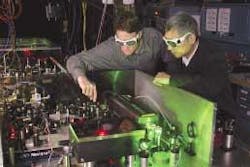In 1967, the 9,192,631,770-Hz resonant frequency of a fountain-like movement of laser-cooled cesium atoms in a microwave cavity captured the internationally accepted definition of the second with a precision that gradually reached one part in 1015 by the mid-to-late 1990s. The idea and most of the groundwork for clocks based on optical as opposed to microwave transitions was also developed during that time, with important innovations arriving close to 2000, such as improved laser stabilization, cold atoms and ions, and the introduction of femtosecond lasers as the "gears" or optical frequency counters for the proposed optical clocks.
Last March, the proposed femtosecond laser gears for enabling atomic clocks passed a major milestone when a team of researchers from national standards laboratories in China, France, and the U.S. reported reproducibly consistent performance of femtosecond-laser-based optical synthesizers in the "generation and control of the frequency of electromagnetic fields over 100 THz of bandwidth with fractional uncertainties approaching one part in 1019."1
The three orders of magnitude by which an optical time and frequency standard might boost accuracy over current microwave systems is likely to have far-reaching effects on terrestrial as well as astronomical metrology. Potential applications range from telecommunications to satellite navigation and tracking remote space probes, and from surveying and mapping Earth's surface with millimeter precision to studying variations in everything from Earth's rotation to the periods of pulsars. The application of this technology to basic questions concerning quantum electrodynamic theory and the variability of fundamental constants has already begun.2, 3
Counting faster cycles
The inability of electronic circuitry to directly count oscillations beyond microwave frequencies has traditionally required the building of elaborate configurations of nonlinear devices to generate higher harmonics from a microwave standard. The idea of using the periodic pulse train (or frequency comb) of an ultrafast laser oscillator to count atomic cycles more efficiently was proposed in the late 1970s, and the development of high-power and robust Kerr-lens modelocked Ti:sapphire technology 20 years later pushed femtosecond lasers into the metrology community as a means to reach terahertz frequencies directly.
Coupling the pulse train from an ultrafast laser oscillator into a photonic-crystal fiber broadens the output spectrum across an evenly spaced optical frequency comb with line spacing equal to the pulse repetition rate. In addition, slippage of the carrier wave relative to the envelope from pulse to pulse can be easily controlled when the spectral bandwidth spanning the frequency comb exceeds an optical octave. "Such a femtosecond laser comb provides a direct link between the optical and the microwave region," according to Theodor Hänsch, whose research team at the Max Planck Institute of Quantum Optics (Garching, Germany) first achieved direct counting of cycles per second in a laser beam in 1998.
"This link can be used in either direction," Hänsch wrote. "If the laser repetition frequency is controlled with a cesium atomic clock, the comb generator synthesizes a vast grid of optical reference frequencies that can be traced to the primary microwave cesium frequency standard on which the definition of the second has been based since 1967. To use the comb synthesizers in the opposite direction, one of the comb lines may be locked to a sharp optical resonance of a cold-trapped ion, of cold atoms, or suitable molecules. All of the other comb frequencies and also the pulse repetition frequency then become known rational multiples of this optical reference frequency. Such a device can act as a clockwork that divides the high frequency of a 'pendulum' oscillating with the frequency of light into the microwave region, where it can be processed and counted with existing electronic circuitry."3
Most recently, an international team of physicists demonstrated precisely reproducible frequency generation and control among four femtosecond laser synthesizers—two at the Time and Frequency Division of the National Institute of Standards and Technology (NIST; Boulder, CO), one at the International Bureau of Weights and Measures (BIPM; Sevres, France), and one at East China Normal University (ECNU; Shanghai, China). The synthesizers were all based upon passively modelocked femtosecond Ti:sapphire lasers with 800- to 1000-MHz repetition rates. In the NIST synthesizers, broadband spectra were directly emitted from four-mirror ring-laser configurations, while BIPM and ECNU spectra from six-mirror ring-laser configurations were broadened in nonlinear photonic-crystal fiber.
During the experiments, one of the NIST laser synthesizers was chosen as a standard and compared to the other three laser synthesizers using optical heterodyning techniques to verify expected frequency positions of output modes relative to a 657-nm (456-THz) continuous-wave reference laser. Despite the differences in laser synthesizer designs, precise control of pulse frequency and phase was demonstrated reproducibly across all the devices.
The experiments firmly establish the femtosecond-laser synthesizer as a reliable tool for optical-frequency comparisons, according to NIST physicist Scott Diddams, a member of the research team. Diddams has also collaborated in demonstrating the first optical atomic clock at NIST referenced to a 1.064-petahertz (282-nm) transition of a single trapped mercury ion.4
"Although optical clocks are significantly more stable than their microwave counterparts, no one has demonstrated an optical clock that is more accurate than the best cesium microwave clocks," Diddams said. "In our most-recent measurements, we have thoroughly tested one component (the "femtosecond laser gears") of emerging optical clocks, and while we believe that optical clocks will indeed be the clocks of the future, there is still much work to be done to reap the full benefits of moving from the microwave to the optical domain."
REFERENCES
- L. S. Ma et al., Science 303, 1843, (March 19, 2004)
- S. Bize et al., Physical Rev. Lett. 90(15): 150802 (April 18, 2003).
- T. W. Hänsch, "Laser Frequency and Time" Online Proc. XVIII International Conf. on Atomic Physics, Publisher: World Scientific, MIT, Cambridge, Mass. (July 27–Aug. 2, 2002).
- S.A. Diddams et al., Science 293, 825 (Aug. 3, 2001).
